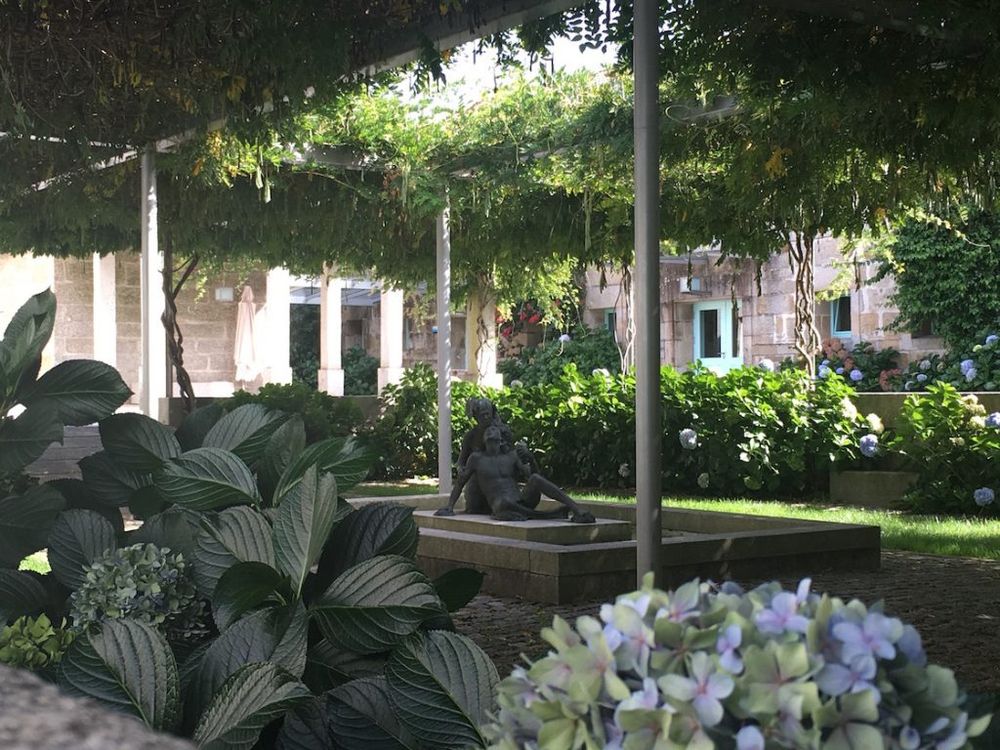It’s not everyday that you sip chilled fine white wine in the gardens of a palace once owned by a drugs lord.

Your car pulls up on the gravel outside the colossal gates that leads to Pazo Baión. The Adam and Eve statues that are stood either side of an enormous drive shaded by orange and lemon trees are a small indication of what’s to come.
There is a feeling that you are somewhere very special. A sense of foreboding almost.

At the end of this immense drive is a 15th century castle that has laid empty since the Spanish government confiscated it off Spain’s largest ever drugs lord Laureano Oubiña in 1995.
At one stage Oubiña’s empire was apparently shifting €2,000 million per annum in contraband. He has ten children.
All around are signs of opulence – shaded gardens with classical statues that now serve wedding parties well, and would also make the perfect setting for a drugs thriller. Starring Al Pacino perhaps.

The tasting room at Pazo Baión
Another extraordinary part of this bodega’s history is that having wrested control of the estate off Oubiña the Government sublet the vineyard for 13 years, then auctioned it off with the successful bidders being a wine cooperative, Condes de Albarei. Talk about power to the people and all that.
The anti-Oubiña feelings here are still so strong that when Oubiña was given a day pass to attend the funeral of his wife who died in a car accident, mothers of drug addicts showed up to hurl abuse.
In a fitting response 5% of the proceeds from every bottle of Pazo Baión wine that Condes de Albarei sells from this estate is donated to drugs charities.
One of the most unique grape-growing estates in Galicia
Of course Pazo Baión has a history that stretches back further than Oubiña and has a reputation as one of the key Albariño estates in Spain, if not the world, situated as it is in the Salnes region that is one of five wine regions of Rias Baixas, an area of North West Spain that has the ideal soil and climate to make this racy, elegant white wine.

The castle of Pazo Baión sits in the middle of one of the most extraordinarily beautiful wine estates that, quite apart from the grand castle, boasts an enormous dairy, the old winery, a state-of-the-art tasting room and a converted pigeon house.
What makes it so unique is because in a region that is made up of tiny smallholdings of grape growers (the end result of divisive inheritance laws) the Pazo Baión estate has 22ha of its own old vines in a natural bowl.
It is a single estate vineyard in a region that has no single estate vineyards.

Old vines held up by granite pergolas
The bowl has its own micro-climate with vines, that have an average age of 35 years (some as old as 80), lined up under an immaculate pergola system and the warmth of the Spanish sun captured by both the granitic soil and this natural ampitheatre.
And so what were the wines like?

As for the wine itself, Pazo Baión is an Albariño that has a lot of body, structure and minerality that all come from this unique spot. The aromatics are intense and full with floral notes of orange blossom and citrus fruits. On the palate there is greater weight and richness than a lot of Albariño has but at the same time there is a freshness that belies its medium-high ABV of 13%.
All the grapes are hand-picked as is customary in the Rias Baixas region, sorted and then given a cool maceration with wild yeast ferment for two weeks then six months on its lees in stainless steel with battonages. 40,000 bottles are produced with premium no-trade a key market.
What is also individual is the bottle shape and logo that looks like a Pacman game but is meant to show the evolution from square granite to round grape.
The wines of Condes de Albarei

Apart from Pazo Baión we tasted the wines of Condes de Albarei, the cooperative that owns Pazo Baion and was formed 30 years ago by 400 partners who collectively own and manage 300 hectares over 3000 plots – you see, I said the region was full of lots of small vineyards!
Their wines were very good and great examples of both classic expressions of albarino as a grape and also hints of where this region is taking these wines.
For me the Albariño Condes de Albarei was the wine of the tasting and interestingly the cheapest and the most mass-produced. They make over a million bottles of this wine for an RRP in the UK of around £10 and yet this is delicious and very well made. It has lifted floral and fruity aromatics, a racy minerality on the tongue with a good salty mineral edge. It is well-balanced and elegant wine. A steal at the price.

Enxebre is their next level up, also very good, the difference being the grapes are picked later from older vines and then given carbonic maceration for a few days. There is more complexity and structure here and a fuller, riper flavour. 100,000 bottles are produced.
Carballo Galego and ‘En Rama’ are limited production Albariño, the first being oak fermented (four months followed by four months in stainless steel), the latter aged (three years on the lees and three years in bottle).
The Buyer will be producing a separate post on aged Albariño in due course. It is an interesting development and one that sommeliers and wine buyers will be wise to keep an eye on – for wines to be drunk with and without food.































